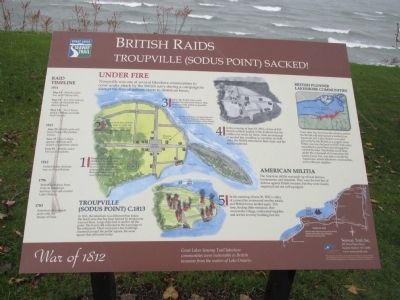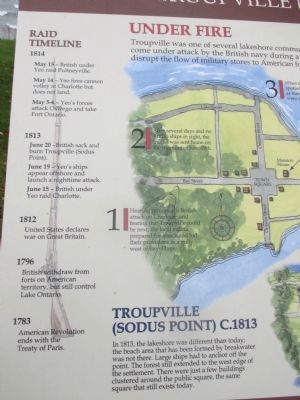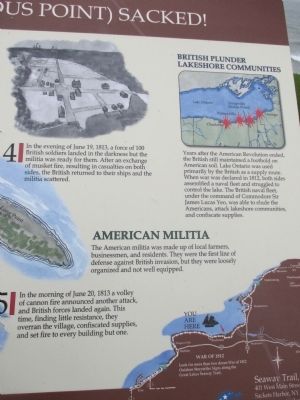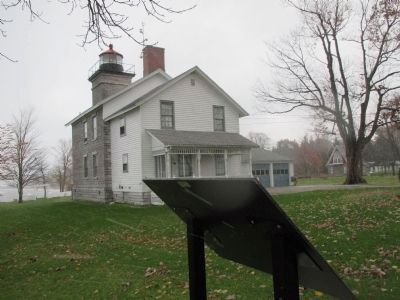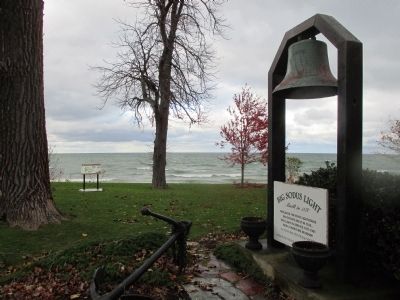Sodus Point in Wayne County, New York — The American Northeast (Mid-Atlantic)
British Raids
Troupville (Sodus Point) Sacked!
— War of 1812 —
Under Fire. Troupville was one of several lakeshore communities to come under attack by the British navy during a campaign to disrupt the flow of military stores to American forces.
Troupville (Sodus Point) c.1813. In 1813, the lakeshore was different than today; the beach area that has been formed by breakwater was not there. Large ships had to anchor off the point. The forest still extended to the west edge of the settlement. There were just a few buildings clustered aound the public square, the same square that exists today.
1. Hearing rumors of a British attack on Charlotte and fearing that Troupville could be next, the local militia prepared for attack and hid their provisions in a gully west of the village.
2. After several days and no British ships in sight, the militia was sent home on the morning of June 19th.
3. When the British ships were spotted the afternoon of June 19th, as many of the militia as possible were called back.
The Mansion house was spared because the wounded American, Asher Warner was taken there for shelter. Asher Warner later died, a plaque marks the site today.
4. In the evening of June 19, 1813, a force of 100 British soldiers landed in the darkness but the militia was ready for them. After an exchange of musket fire, resulting in casualties on both sides, the British returned to their ships and the militia scattered.
5. In the morning of June 20, 1813 a volley of cannon fire announced another attack, and British forces landed again. This time, finding little resistance, they overran the village, confiscated supplies, and set fire to every building but one.
American Militia. The American militia was made up of local farmers, businessmen, and residents. They were the first line of defense against British invasion, but they were loosely organized and not well equipped.
British Plunder Lakeshore Communities. Years after the American Revolution ended, the British still maintained a foothold on American soil. Lake Ontario was used primarily by the British as a supply route. When war was declared in 1812, both sides assembled a naval fleet and struggled to control the lake. The British naval fleet, under the command of Commodore Sir James Lucas Yeo, was able to elude the Americans, attack lakeshore communities, and confiscate supplies.
Raid Timeline.
1814: May 15- British under Yeo raid Pultneyville. May 14- Yeo fires cannon volley at Charlotte but does not land. May 5-6 -Yeo's forces attack Oswego and take Fort Ontario.
1813: June 20- British sack and burn Troupville (Sodus Point). June 19- Yeo's ships appear offshore and launch a nighttime attack. June 15- British under Yeo raid Charlotte.
1812: United States declared war on Great Britain.
1796: British withdraw from forts on American territory, but still control Lake Ontario.
1783: American Revolution ends with the Treaty of Paris.
Great Lakes Seaway Trail lakeshore communities were vulnerable to British invasion from the waters of Lake Ontario.
War of 1812. Look for more than two dozen War of 1812 Outdoor Storyteller Signs along the Great Lake Seaway Trail.
Seaway Trail, Inc., 401 West Main Street, Sackets Harbor, NY 13685. America's Byways. This project was funded in part by the Federal Highway Administration and administered by the New York State Scenic Byways Program of the New York State Department of Transportation and Seaway Trail, Inc.
Erected by Seaway Trail, Inc.
Topics and series. This historical marker is listed in this topic list: War of 1812. In addition, it is included in the Great Lakes Seaway Trail National Scenic Byway series list. A significant historical date for this entry is June 19, 1813.
Location. 43° 16.438′ N, 76° 59.178′ W. Marker is in Sodus Point, New York, in Wayne County. Marker is at the intersection of North Ontario Street and Lake Street on North Ontario Street. Marker is between the lighthouse and the Lake Ontario shore. The intersection of North Ontario Street and Lake Street is actually a 90 degree turn. Touch for map. Marker is at or near this postal address: 7606 North Ontario Street, Sodus Point NY 14555, United States of America. Touch for directions.
Other nearby markers. At least 8 other markers are within walking distance of this marker. Big Sodus Light (a few steps from this marker); Sodus Point Lighthouse (within shouting distance of this marker); Site of the Original Sodus Bay Lighthouse (within shouting distance of this marker); Site of 1825 Keeper's Dwelling House (within shouting distance of this marker); Battle of Sodus Point (approx. 0.3 miles away); The War of 1812 (approx. 0.3 miles away); Historic Sodus Point (approx. 0.3 miles away); A French Inspired Flotilla (approx. 0.4 miles away). Touch for a list and map of all markers in Sodus Point.
More about this marker. "Charlotte" on the marker refers to the junction of the Genesee River and Lake Ontario at Rochester, NY.
Regarding British Raids. The U.S. counterpart to Commodore Yeo was Commodore Isaac Chauncy, based at Sackets Harbor. Raids from ships were committed by both Lake Ontario navies during the war. Control of the lake hinged upon naval superiority and therefore a shipbuilding race. For more information about the struggle for control of Lake Ontario during the War of 1812, see Malcomson, Robert, Lords of the Lake: The Naval
War on Lake Ontario. U.S. Naval Institute Press, 1999.
Also see . . .
1. Sodus Bay Lighthouse Museum. Marker is on the grounds of the lighthouse museum. (Submitted on December 12, 2014, by Anton Schwarzmueller of Wilson, New York.)
2. Historic Sodus Point - Sodus Bay Historical Society. (Submitted on December 13, 2014, by Anton Schwarzmueller of Wilson, New York.)
Credits. This page was last revised on June 16, 2016. It was originally submitted on December 12, 2014, by Anton Schwarzmueller of Wilson, New York. This page has been viewed 629 times since then and 30 times this year. Photos: 1, 2, 3, 4, 5. submitted on December 12, 2014, by Anton Schwarzmueller of Wilson, New York. • Bill Pfingsten was the editor who published this page.
